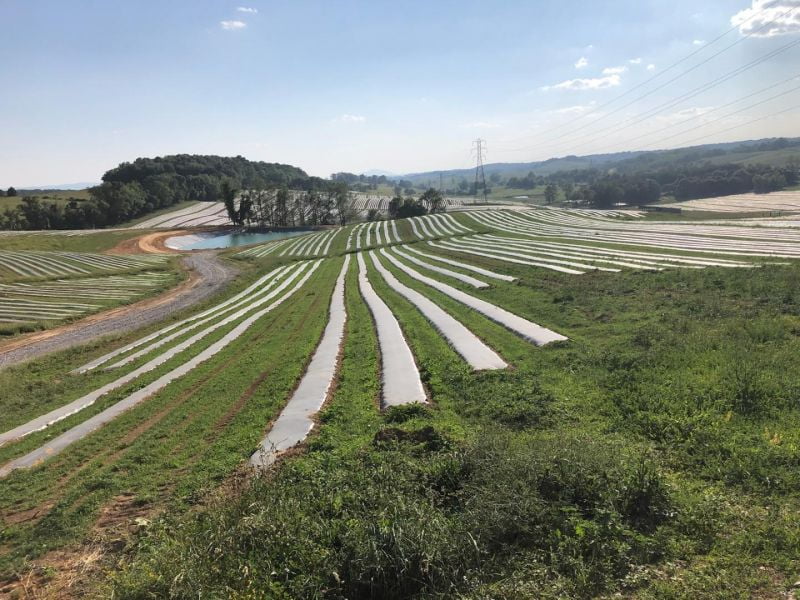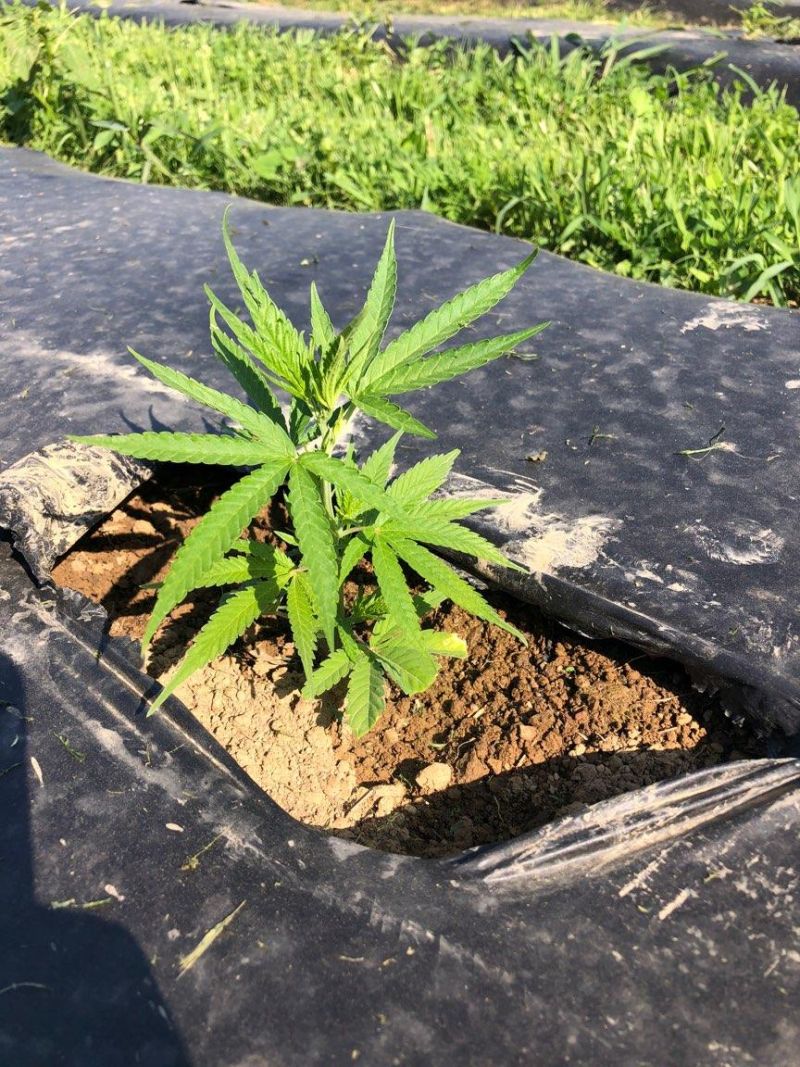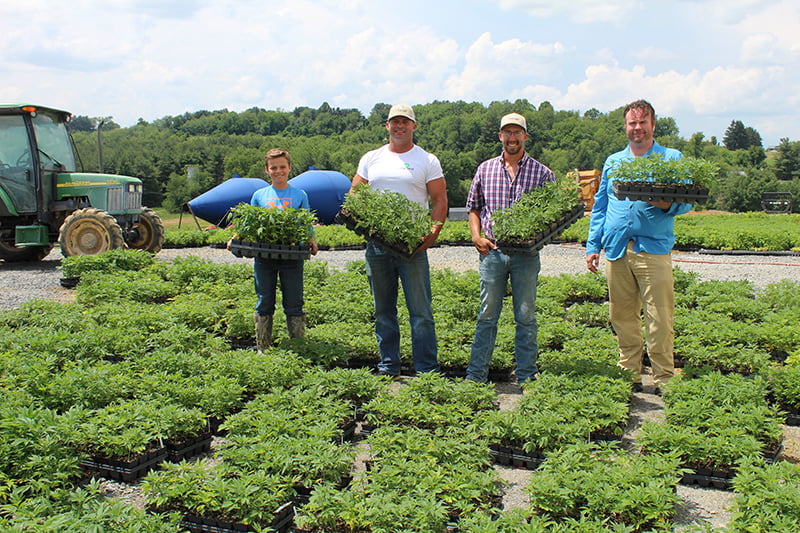
Mound growing fields have been planted with hemp just outside Christiansburg.
Marty Gordon
Legislation passed by the Virginia General Assembly earlier this year has opened the door on a new agricultural product that dates to the early Jamestown and Williamsburg years. Hemp was once a mainstay crop in the Commonwealth producing feed, fiber and fuel. Although hemp cannot produce a high, the crop was banned in the U.S. in the 1930s for its association with the drug marijuana to which it is related.
Nearly fifty years later, the 2018 U.S. Farm Bill made it legal for farmers to harvest the crop, and the Virginia Department of Agriculture and Consumer Services has issued close to 100 permits to grow the crop in this state.
Matt Hagan, a Montgomery County cattle farmer who is known for race-car driving, is banking on the crop. He recently planted over 100,000 hemp seedlings on a 100-acre spot near Christiansburg, making him one of the largest growers in the state.
Hagan is a professional NHRA funny car driver for Don Schumacher Racing. Most notably, he was the 2011 and 2014 NHRA Funny Car World Champion. He is also the owner of approximately nine farms in Montgomery County and three other localities in southwest Virginia.
The land where he has planted hemp used to be home to Flanagan Horse Stables and was commonly known as the “big red barn.”

The description could now change as the barn, off Interstate 81 near Carilion Radford Community Hospital, has been painted white and holds the name of Hagan’s new venture, TruHarvest Farms.
Hemp, according to Hagan, has been on his radar for several years. “I’m excited about this project, and I’m learning something new every day.”
Another former Montgomery County farmer and a member of the county’s board of supervisors is also optimistic about the future of the crop.
Jim Politis has been a major advocate for the past five years to legalize the growing of hemp and has served as a member of the Virginia Industrial Hemp Coalition.
“I’ve always been an activist. I was one of the first farmers around here to raise buffalo. I’ve always taken risks,” Politis admitted. Now, he believes lots of farmers will also take the risk on hemp.
“I’m excited about what Matt is doing, and hope it will continue to grow as a whole across the entire state of Virginia,” he said.
Hemp is used in clothing fiber, food products and hair products, but it’s the oil that the Commonwealth has given farmers the okay to start producing.
The oil has been labeled in dietary supplements and a possible product in helping to ease headaches and other health problems. Hemp oil has been reported to ease arthritis pain, help sufferers of MS and reduce inflammation and chronic pain.
CBD or cannabidiol, is a compound that can be extracted from both hemp and marijuana.
While the two plants are in the same family, they are different. The key is the amount of THC (tetrahydrocannabinol) that is found in the leaves of the crop. THC causes a high. Hemp is high in CBD and low in THC, while marijuana is high in THC and low in CBD.
Monitoring the THC levels requires a test on a weekly basis. John Straw, who is Truharvestfarms’ head grower and longtime farmer, admits hemp is something very new to him.
“The requirement to test the oil in the crop is a biggie and something that has been to be done to be able to sell it,” he said.
If the THC level exceeds state-allowed concentrations, the crop cannot be sold and would have to be burned.
In addition, because of the complexity of the crop, all the planting had to be done by hand, and everything else that follows will also have to be done by hand. A large group of workers spent three days placing plants across the acreage.
“Last week, we hand-planted the seedlings. We will now have to hand weed the field and mow between each mound planting,” Hagan said.
The parcel of land has three wells on the site, and close to 1.2 million gallons of water is needed weekly to keep the plants growing properly. The farmer turned racecar driver is already looking to another 400-acre site to increase future hemp production.
One of the pluses Hagan sees, is the proximity to Virginia Tech who is doing research on hemp.
John Fike is the university’s point person for evaluating industrial hemp and its potential to boost economic development in Virginia.
An associate professor in the School of Plant and Environmental Sciences, he sees both challenges and opportunities in the new market.
“The general consensus is that hemp will at least be another quiver in the arrow of potential crops for producers to grow, but several market features will affect that,” Fike said in a university release, “Entry for each of these potential commodities comes with its own set of challenges.”
Tech researchers are studying what hemp varieties are suitable to Virginia soils and climate, while at the same time examining the fiber properties of hemp and its pest management.
“We have learned the plant is host to a tremendous number of insects, and my colleagues in entomology are trying to better understand the potential impact they may have,” Fike said.
Financial implications for this type of growing has been called “huge” and figures from the Virginia Farm Bureau estimate the profit can be anywhere from $4,000 to $20,000 an acre. But the investment does come with significant start up costs – an individual seed can cost a dollar – a well as risk since agronomic research on the crop ended in the 30s when production was banned.

“I would not be surprised to see many producers trying to grow a little hemp, just to see how it will work with their operation and on their farms. But market uncertainty – that is, can it make a profit? – and other challenges may initially slow the pace of industrial development,” Fike said.
The Hemp Industries Association, a national advocacy group that has been pushing for more production of the crop, estimates that $573 million of retail products were sold annually in the past four years and says the demand continues to grow.
Fourteen states have established industrial hemp programs. Most of the hemp currently being used is produced in China, Russia and South Carolina.
The first crop at Truharvestfarms could be ready to harvest in 60-90 days. Until then, Hagan will have his other job as a racecar driver to fall back on.

